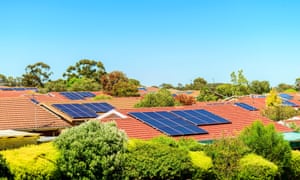Government renovation grants for new builds and renovations could
have ensured homes are more energy-efficient and cheaper to run
The federal government’s $688m homebuilder package might protect residential construction jobs but
it’s a missed opportunity to deliver sustainability benefits that would
save owners money in the long run. The $25,000 grant for new homes and
renovations could have been better leveraged to provide broader and ongoing benefits. In particular, it could have been used to ensure homes are more energy-efficient and cheaper to run.
The grant is available for building an owner-occupied home with
property values (house and land) under $750,000. Renovations costing
between $150,000 and $750,000 for a property valued under $1.5m are also
eligible. Grants are means-tested against household incomes.Building houses better
The scheme could have required new houses to exceed minimum building code requirements to be eligible. The development industry would then have had to deliver housing to this standard or risk losing potential buyers. Using the right design and materials would mean any extra costs are recouped over time.Heating and cooling energy use could be reduced by almost 25% across capital city climate zones with minimal requirements. New houses could achieve these reductions with a solar PV system and seven-star performance rating (in line with proposed changes to raise the national construction code’s current six-star minimum in 2022). This would reduce utility bills and carbon footprints for householders.
The use of majority Australian-made materials could be stipulated. Local renewable energy, insulation and energy-efficiency businesses would benefit from increased demand. Job creation would follow in these and secondary industries.
Combining these sustainability measures through homebuilder would provide benefits across the lifetime of new houses.
Renovation to help everyone
Restricting homebuilder grants to renovation projects over
$150,000 excludes many modest renovations like upgrading a kitchen or
bathroom. It has already been called a handout for the rich.
Much of the existing housing stock in Australia has poor energy and thermal performance. Many houses are too hot in summer or too cold in winter, or both.A better and more equitable strategy would be to provide renovation grants for energy-efficiency retrofits in owner-occupied and rental housing.
Retrofits could be undertaken for a fraction of the price of the renovation grant and still help a range of trades. There would be demand for heating and cooling systems, insulation and draught-proofing to be supplied and installed. Households would save on bills and suffer less from extreme temperatures.
Energy-efficiency retrofits are a cost-effective way to improve environmental performance, thermal comfort, health and well-being. Much of Australia’s existing housing stock could be upgraded to five stars for much less than the budgets required by the announced stimulus.
Retrofits should be determined by an in-house sustainability assessment by qualified assessors – another potential growth area. Programs like the Victorian residential energy scorecard already offer guidance on best practice. Identifying the best retrofitting opportunities for individual properties would ensure each household gets best value for money.
Capturing wider benefits
A more strategic approach to homebuilder could help the economy and move us towards a lower-carbon future.The need to upskill tradies and limitations of local manufacturing are often cited as barriers to improving the sustainability of Australian housing. Homebuilder could offer incentives to overcome these obstacles. Setting higher building performance standards as a condition of the homebuilder grant would upskill workers and create jobs.
Tradies would have the opportunity to work on tens of thousands of houses with higher performance ratings. This would provide extensive professional experience of building more sustainable housing across the country. Local manufacturing and secondary industries could innovate and supply sustainable building materials and technologies for Australian conditions.
Improving housing sustainability would also help achieve broader federal and state government policy goals. For a start, it would help Australia achieve targets for reducing greenhouse gas emissions. It would also help with issues such as energy vulnerability and security.
As a final note, economists, housing researchers and social housing organisations argue that a program designed to deliver more social housing would provide greater benefits. Australia certainly needs to increase its social housing stock. Homebuilder could have helped with this.
If future stimulus schemes target social housing, we suggest environmental and energy performance should be top priorities from the outset.
- Trivess Moore is a senior lecturer at the school of property, construction and project management, RMIT University. Tony Matthews is a senior lecturer in urban and environmental planning at Griffith University
- This article is republished from The Conversation under a Creative Commons license. Read the original article.

No comments:
Post a Comment